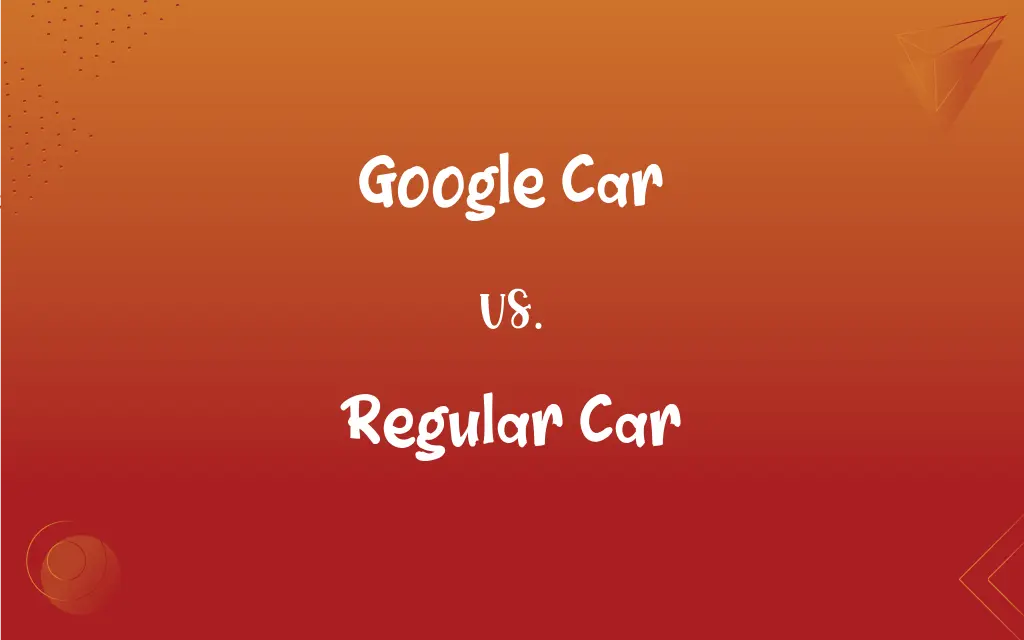Google Car vs. Regular Car: What's the Difference?
Edited by Janet White || By Harlon Moss || Updated on October 21, 2023
A Google car (Waymo) is a self-driving vehicle utilizing advanced AI technology, while a regular car requires manual control by a human driver.

Key Differences
A Google car, now known as Waymo, is a groundbreaking innovation representing the convergence of transportation and advanced technology. Unlike traditional vehicles, this car is equipped with state-of-the-art sensors, LIDAR, and artificial intelligence algorithms that enable it to navigate roads autonomously. On the other hand, a regular car relies on human intervention for operations like steering, braking, and accelerating.
While both the Google car and the regular car can transport individuals from one location to another, their mechanisms are starkly different. The Google car possesses cameras and sensors that feed real-time data to onboard computers, interpreting this data to make driving decisions. Contrarily, a regular car demands the driver to process environmental cues and respond accordingly, relying heavily on human judgment.
Safety features and considerations further differentiate the Google car from its traditional counterpart. Enhanced by its technological advancements, the Google car is designed to reduce human error, one of the primary causes of road accidents. Regular cars, though they may have some modern safety enhancements, ultimately depend on the driver's skill and attentiveness.
In terms of user experience, the Google car promises a future where passengers can be completely hands-free, potentially using commute time productively or leisurely. A regular car, however, often demands full attention from the driver, making multitasking challenging and potentially unsafe.
As the automobile industry evolves, the distinction between a Google car and a regular car will continue to become more pronounced. With the surge in autonomous driving technology, cars like Waymo aim to redefine our relationship with vehicles, whereas regular cars serve as a testament to traditional driving experiences.
ADVERTISEMENT
Comparison Chart
Driving Mechanism
Autonomous using AI
Manually driven by humans
Technology Integration
Advanced sensors, LIDAR, and AI
Basic electronics, some may have advanced safety features
Primary Safety Dependence
AI algorithms and sensors
Human judgment and skill
User Experience
Hands-free, no driver intervention required
Requires driver's full attention
Adaptability
Can be updated with software for improved performance
Static features unless physically modified
ADVERTISEMENT
Google Car and Regular Car Definitions
Google Car
A vehicle equipped with state-of-the-art sensors for navigation.
Using LIDAR, the Google car can detect obstacles in real time.
Regular Car
A car without autonomous driving capabilities.
Parking a regular car requires the driver's skill and attention.
Google Car
A car that reduces the need for human driving intervention.
With the Google car, long drives could become more leisurely for passengers.
Regular Car
A testament to conventional driving experiences.
Many enthusiasts still prefer the tactile experience of a regular car.
Google Car
A car integrated with advanced AI for self-driving.
The Google car promises a future of reduced traffic accidents.
Regular Car
A car operated manually without AI intervention.
Despite advancements, the charm of a regular car remains for many.
Google Car
A representation of cutting-edge autonomous transportation.
Many tech enthusiasts eagerly await the commercial release of the Google car.
Regular Car
A traditional vehicle requiring human control.
She learned to drive on a regular car with manual transmission.
Google Car
An autonomous vehicle by Google's subsidiary, Waymo.
The Google car navigated the streets seamlessly during its test run.
Regular Car
A vehicle primarily dependent on human judgment.
In heavy traffic, the regular car driver had to remain especially alert.
FAQs
Is the Google car available for public purchase?
As of my last update, Waymo (Google car) was focused on ride-hailing services rather than individual sales.
What powers the Google car's autonomous capabilities?
Advanced AI algorithms, sensors, and LIDAR technology power the Google car.
What's the primary safety mechanism in a Google car?
The Google car relies on AI-driven real-time data processing from its sensors for safety.
Are Google cars electric?
Many of the Waymo vehicles (Google cars) are electric or hybrid, aligning with a sustainable approach.
Do regular cars possess any autonomous features?
Some modern regular cars have semi-autonomous features like adaptive cruise control or automated parking, but they aren't fully autonomous like the Google car.
How do regular cars impact the environment?
Regular cars, especially those using gasoline, contribute to emissions; however, electric or hybrid regular cars have a reduced environmental impact.
Are there any legal challenges for Google cars?
Yes, autonomous vehicles like the Google car face various regulatory and legal challenges that differ by region.
Can you manually drive a Google car?
Early models had manual controls, but Waymo has been developing fully autonomous models without traditional controls.
What's the fuel source for most regular cars?
Most regular cars run on gasoline or diesel, but electric and hybrid variants are becoming more common.
How does the Google car handle traffic scenarios?
The Google car uses its sensors and AI to interpret traffic scenarios and respond appropriately.
How does the Google car "see" the road?
The Google car uses a combination of cameras, LIDAR, and other sensors to get a 360-degree view of its surroundings.
What's the future of Google cars and regular cars coexisting?
Both can coexist, catering to different needs, with infrastructure and regulations evolving to support both types of vehicles.
Can a regular car be converted into an autonomous one?
While some kits and upgrades offer partial automation, full conversion is complex and may not match dedicated autonomous vehicles like the Google car.
Will Google cars replace regular cars?
While Google cars might become more prevalent, it's uncertain if they'll completely replace regular cars, given the diversity of user preferences and needs.
How does a regular car function?
A regular car functions through manual control and operation by a human driver.
How do maintenance needs compare between the two?
Google cars might require specialized maintenance for their tech components, while regular cars focus on mechanical upkeep.
Can Google cars travel long distances?
While Google cars can handle long distances, factors like software, battery life, and sensor calibration could be considerations.
What's the charm of driving a regular car?
Many find pleasure in the tactile experience, control, and tradition of driving a regular car.
Is it expensive to own a regular car?
Costs for regular cars vary widely based on brand, model, fuel efficiency, and maintenance needs.
Can regular cars be more reliable in certain situations?
Some argue that human intuition in complex or unpredictable scenarios might make regular cars more adaptable in certain situations.
About Author
Written by
Harlon MossHarlon is a seasoned quality moderator and accomplished content writer for Difference Wiki. An alumnus of the prestigious University of California, he earned his degree in Computer Science. Leveraging his academic background, Harlon brings a meticulous and informed perspective to his work, ensuring content accuracy and excellence.
Edited by
Janet WhiteJanet White has been an esteemed writer and blogger for Difference Wiki. Holding a Master's degree in Science and Medical Journalism from the prestigious Boston University, she has consistently demonstrated her expertise and passion for her field. When she's not immersed in her work, Janet relishes her time exercising, delving into a good book, and cherishing moments with friends and family.
































































